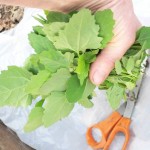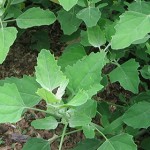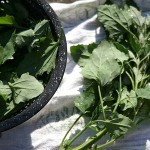Budget eating, with all the locavore/organic/foodie brownie points you care to collect.
Do People Know About This?
One of the most common garden weeds is also known as Wild Spinach, and indeed, it is edible and delicious. With a deeper & more robust flavor than spinach, and without that squeaky teeth feeling, I can’t believe I didn’t know about this before. I figured if I, as a weed-loving naturopathic doctor didn’t know about this weed, you might not, either.
So, introducing Chenopodium album – lambs quarters, aka pigweed aka wild spinach. Why the multiple names? Well, more than one plant is referred to as both lamb’s quarters and as pigweed, and this one is actually related to spinach, so the latter name is more functional. The former name is more common, however, so I am presenting you with options.
Nutritional information: good for you! Rich in magnesium and potassium, more fiber, beta carotene (pro-vitamin A), vitamin C, riboflavin, calcium, zinc, copper and manganese than domestic spinach. Domestic spinach has more iron and folic acid. (From Edible Wild Plants”: Wild Foods from Dirt to Plate, by John Kallas, PhD)
In my garden, wild spinach colonized the garlic patch and was happily taking up all the space between the garlic plants. I was waiting for them to get big, and then one day I realized they were starting to shade my garlic. This won’t do, I thought. I must weed. And then I must be an adventurous weed-lover, and cook the weeds for dinner!
I pulled the wild spinach out by the roots, as I couldn’t have it shading my garlic, but you can also selectively harvest to allow your plants to keep producing throughout the summer.
Top reasons to eat weeds:
- They are free
- They are nutrient dense
- They are tasty
- You get points for being a locavore and slow foodist
- You feel virtuous for being a locavore & slow foodist, as well as for eating really healthy food for cheap.
- You get to meet the neighbors (when they ask you what you are doing over in the abandoned lot with your kitchen scissors and colander)
Harvesting Steps:

Step away from your screens, and go outside.
- Bring scissors and a large bowl/basket/bag for collecting your greens.
- Let go of getting things done. Harvesting and prepping plants for dinner is contemplative and slow.
- Always first confirm the identity of the plants you are planning to eat! Consult books and people who know these things.
- Make sure the patch you are harvesting from is growing in uncontaminated soil. Ideally, this means it is in your yard, or your friend’s yard, or a green space whose history you know (ie, not a green space that was created over a massive garbage dump or industrial waste site!)
- If it is sunny, wear a hat. And sunglasses. Best sun protection there is.
- Harvest your greens. If the weed patch is on your property, it is up to you whether you level the whole patch for spanakopita, or save some for sesame-greens next week. If it is a public patch, the general rule for wildcrafting is never remove more than 30% of an area’s growth of that plant. This is a super-common weed, so you shouldn’t have any trouble abiding by these happy harvesting guidelines.
- You can cut individual stems, pile them up and do the prep (of removing leaves from stems and setting aside stems for composting) in the kitchen, or you can snip leaves off individually and leave the stems growing.
Now what?
Here’s a simple greens recipe to get you going:
Garlicky-Sesame Greens
One overflowing colander full of wild spinach, washed, big stems removed (or any other greens)
1-4 cloves garlic, minced or chopped
1-3 tbsp Toasted sesame oil
1-3 tbsp Tamari (wheat-free natural soy sauce)
1-2 tbsp Olive oil
3 tbsp Sesame seeds, toasted in a hot, dry pan
½ tsp Sea Salt, or to taste
Water for sauteing
Heat olive oil in a sauté pan, add garlic and stir for a minute or so. Add greens, stirring as you can. Sprinkle with sea salt, and sauté, adding water and putting a lid on the pan if necessary to wilt & cook the greens. Just before they seem done, add tamari and stir to mix through. Remove from heat. Garnish with toasted sesame oil and sesame seeds. Serve with grilled fish/tempeh/chicken etc.
Feel smug and healthy.






